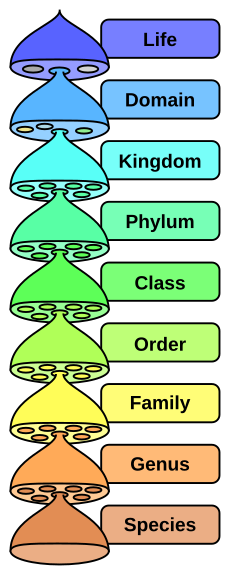Let's Get Started
Let’s learn about how organisms are named and classified based on common characteristics. Before you get started, don’t forget to print out your OnTRACK Biology Journal.
TEKS Standards and Student Expectations
B(8) The student knows that taxonomy is a branching classification based on the shared characteristics of organisms and can change as new discoveries are made. The student is expected to:
B(8)(A) define taxonomy and recognize the importance of a standardized taxonomic system to the scientific community
Learning Objectives
Describe what taxonomy is and why it is important.
Describe binomial nomenclature and use scientific names of species correctly.
Explain how the methods used to classify organisms have changed over time.
Relate phylogeny to the "tree of life."
Essential Questions
What is taxonomy?
Why is taxonomy important?
What are the benefits of using a scientific name rather than a common name when discussing an organism?
How has systematics changed over time?
How is phylogeny related to the “tree of life"?
Vocabulary
- Taxonomy
- Common Names
- Scientific Names
- Systematics
- Binomial Nomenclature
- Phylogeny
What is Taxonomy and Why is it Important?
Look closely at this picture from the National Museum of Natural History.
Each of those wooden drawers holds a different species of bird. In fact, this museum houses one of the largest collections of birds in the world. This collection represents 80% of the world's diversity of birds.
How do scientists keep up with all the different species? The answer is taxonomy! Taxonomy is the science of classifying living organisms. Take a look at what the paleontologist David Hone has to say about why taxonomy is important:
What's in a Name?
Look at this picture. What animal is it?

You might have called it a cougar, a puma, a mountain lion, or a panther. All of these are common names for this animal. The scientific name, however, is Felis concolor. Scientific names contain a lot of subtle information about an organism. Watch the video Learn Biology: Classification - The Taxonomic Hierarchy to learn where the scientific name Felis concolor comes from.
|
As described in Learn Biology: Classification - The Taxonomic Hierarchy, all life is classified in increasingly specific groups that end with the most specific category, the individual species. Early taxonomist classified organisms into different categories based on their physical characteristics and presumed natural relationships. Now, with the understanding of genetics and evolution, scientists have more clues as to how to classify organisms. Systematics is the study of the diversity of life on the planet Earth, both past and present, and the relationships among living things through time. Binomial nomenclature is the formal, two-word naming system that assigns a scientific name, consisting of the organism's genus and species, to each organism. Scientific names are written in italics. The first word (the genus) begins with a capital letter, and the second word (the species) is lowercased. The cougar pictured above is genus Puma and species concolor, so its scientific name is Puma concolor. Each genus contains animals that have very similar features and are closely related. For example, the Felidae (Cat) family contains genus Felis (small cats and domestic cats), genus Panthera (tigers, leopards, jaguars, and lions) and genus Puma (panthers and cougars). The most specific category, species, is often defined as organisms having common characteristics that are (usually) capable of mating with one another to produce fertile offspring. |
 |
Directions: Click on the following common names to view the "secret" information contained in each organism's scientific name.
Tree of Life
Taxonomists not only give names to organisms, they also place them in "family trees" based on a taxonomic system of relationships. This system is constantly revised to reflect new knowledge about organisms. The most current studies use the term "tree of life" to refer to this evolutionary family tree, and phylogeny to refer to the evolutionary history of an organism—its path along the branches.
Directions: Watch the video Discovering the Great Tree of Life to learn more about how the tree of life system allows us to see relationships between organisms. After viewing, respond to questions 5–11 in the OnTRACK Biology Journal.

